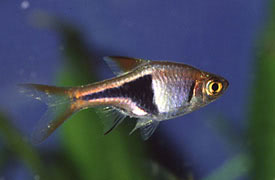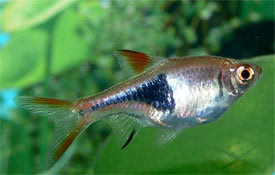
 Magyarul / Hungarian
Magyarul / Hungarian


- Scientific name: Trigonostigma heteromorpha
- Synonyms: Rasbora heteromorpha
- Common name: Harlequin rasbora
- Group: Cyprinids
- Habitat: Southeast Asia; Malay Peninsula, Sumatra,Thailand.
- Size: 4 cm
- Biotope: Still and slow-moving brooks and swamps, in shallow areas.
- Social behavior: A peaceful, schooling fish that should be kept in groups of six or more. Combinethis species with other small to medium sized, schooling fish.
- Diet: Live, insects, insect larvae , crustaceans, Tubifex, flakes.
- Breeding: Moderately difficult
- Tank: Minimum 65 litres
- Population: 10 fishes for 85 litres
- Decoration: Use a dark gravel substrate and a partialcover of floating plants.Use dense planting along the edges and sides of the tank. Provide hiding places in these thicketsof plants, and in wood and roots.
- Temperature: 24-28 °C
- pH: 6-6,5
- Hardness: 4,5-8,5NK°
- Lifespan: 5-6 years
Description: Perhaps the most characteristic feature of this species is the triangular shaped, Blackish Blue marking, which begins wide in the center of the body and becomes narrower as it extends back to the start of the Caudal fin. In the females the lower front of the Triangle is often indistinct, while in the males it has a sharp edge that extends down toward the belly area. The dorsal fin is a Red color with a yellow tip. The upper and lower tips of the Caudal fin are a bright Red with the inside rays being a pale Yellow. The Base coloration of the body is a silver color and the sides range from a Pink all the way to a Copper color.
All Rasbora species are peaceful and unaggressive and can be kept with fish of similar temperament. They are strong swimmers and in nature prefer to be in small schools. They like to stay in the upper areas of the aquarium. Your tank should provide plenty of open space for swimming as well as some dense plantings to serve as shelter. The water temperature should be kept around 76f. Rasboras prefer soft water and if possible you should use a peat filter bag in your filter, (Tetras will benefit also) They will eat flake, frozen as well live food.
Many species of Rasbora will breed without too much difficulty, spawning freely in soft, neutral or slightly Acidic water. Unfortunately Rasbora Heteromorpha is not one of these. The water should be very soft with a hardness of 1.5 to 2.5 DH and a Ph of around 6.0. A long breeding tank is also beneficial with a dark substrate. The mating consists of the pair lying upside down under a leaf or similar with the male curling his tail around the female. It may take several days in the spawning tank before mating takes place. The parents will eat their own eggs so it is very important to remove them from the tank right away. After the parents are removed you should carefully lower the water to a depth of four or five inches. The eggs will hatch in 24 to 30 hours and in three to five days the fry become free swimming. The young should be fed on baby brine shrimp and other small foods. Growth is fairly rapid.














